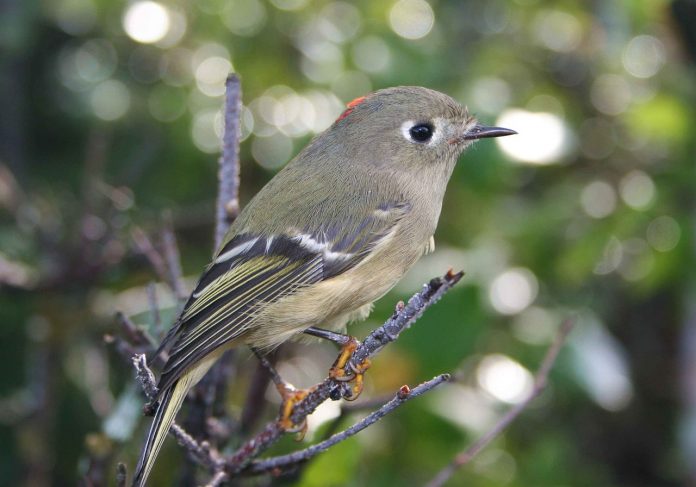If asked to name the smallest bird that visits backyard feeders, I suspect most people would answer “hummingbird.” And that would be correct.
At less than four grams (28.3 grams = one ounce), these tiny dynamos are marvels of physiology, anatomy and aerodynamics. But if we limit the question to songbirds or perching birds such as cardinals or robins, the most frequent answer would probably be “chickadee.”
And at 10 to 12 grams, these little puffballs of feathers are tiny indeed. But the correct answer is “kinglets.”
Two species inhabit most of North America. Golden-crowned and ruby-crowned kinglets prefer coniferous forests at higher latitudes and higher elevations. Golden crowns weigh in at six grams, ruby-crowns at seven grams.
Weight comparison
That’s half the size of chickadees. For a more familiar comparison, a brand new nickel weighs exactly five grams. Kinglets winter across the lower 48 states, but some golden crowns remain as far north as Maine and northeastern Canada.
Kinglets are small, olive-colored birds. Both species are tiny, olive colored, about four inches long, have wing bars, and their bellies are lighter than their bodies. Look to their heads for differences between these two insectivorous songbirds.
Black stripes border the fiery crowns of the heads of both male and female golden-crowns. Both sexes also wear a broad white eyebrow stripe, so the head has a distinctly striped appearance. Ruby-crowns are duller. Females lack the red hat that characterizes males, though the male’s red feathers are seldom visible.
Only when males get excited or agitated, perhaps by the presence of a hawk, do they erect these feathers and display the colorful ruby crown. The keys to recognizing ruby-crowns are the white eye-ring and the absence of stripes on the head.
Like many birds, kinglets are often heard before they’re seen. Their high-pitched call notes are distinctive.
Signs to watch
Look for tiny greenish birds hovering as they glean prey from conifers’ evergreen needles. Even in the dead of winter with temperatures below zero, kinglets eat live food. And as you scan the treetops with binoculars, watch for constant movement.
Kinglets are perpetual motion machines as they hunt for tiny insects you can never see from the ground. Kinglets nest in the coniferous forests of the Rocky Mountains and across the northern U.S. and Canada, though golden-crowns also nest south along the spine of the Appalachians.
Remarkably, these tiny birds lay clutches of seven to 12 eggs. They accommodate such large clutches by arranging the eggs in two layers.
Furthermore, the nest is usually so deep that the incubating female is hidden beneath the rim of the nest. Also, the nest is usually placed directly beneath a small branch to conceal it from above and protect it from snow and rain.
Unfamiliar to many
The female alone builds the nest and incubates the eggs for 12 to 15 days. Two broods are typical. Because kinglets are so small and only visit backyards occasionally, they’re unfamiliar to many people.
But if you know what to look for, they’re easy to spot. Be alert for tiny active birds high in the treetops. Golden-crowns usually work alone or associate with other golden-crowns. Ruby-crowns are more social and often join loose flocks of chickadees, titmice, and brown creepers.
Kinglets forage at the tips of branches and sometimes hover while gleaning small invertebrates and egg cases from hard-to-reach needles and twigs. They move constantly and flick their wings as they fly from limb to limb.
These very behaviors, coupled with the distinctive head markings, make identifying kinglets manageable. But exactly what are kinglets eating high in the treetops in mid-winter? How can such tiny birds overwinter in places where nocturnal temperatures often plunge below zero?
Eating the kill
It turns out that some moths overwinter in the treetops as tiny fleshy caterpillars, and kinglets eat their fill every day. Kinglets typically ignore the seeds we offer in feeders because they lack seed-cracking bills.
They do, however, supplement their diet of live food with suet or peanut butter/suet mixes. So watch for kinglets at suet feeders on frigid winter mornings.













